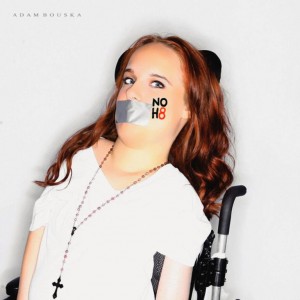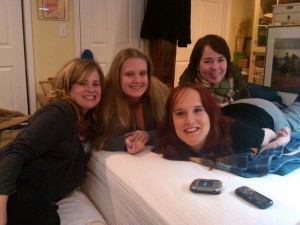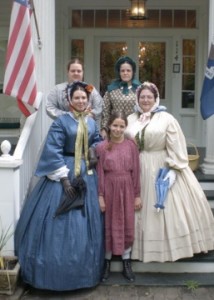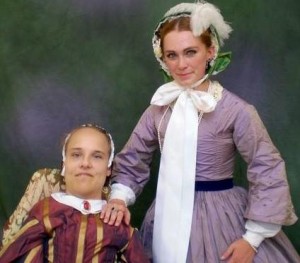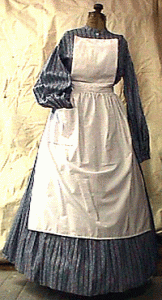 Since Arthrogryposis Awareness Day is coming up on June 30, I wanted to update this old blog about what it means to be a 30-year-old woman living with Arthrogryposis in this world.
Since Arthrogryposis Awareness Day is coming up on June 30, I wanted to update this old blog about what it means to be a 30-year-old woman living with Arthrogryposis in this world.
What can you do for Arthrogryposis Awareness Day?
I’m going to make a video this year like I did last year. Each June 30, people are encouraged to wear blue to show support for people who were born with the condition and the need to educate people about it. We don’t have a celebrity spokesperson throwing charity events to raise money and pressure medical science to do more research for more effective treatments. I’m asking you to wear blue on June 30, take a picture or video of yourself and send it to me at jessicajones9828@gmail.com so that from there, I will put your contribution into a video. People have gotten creative before with blue nail polish, blue ribbons, blue hair streaks, or anything else if simple blue clothes don’t interest you. If you choose to send a video, please tell people why you support Arthrogryposis Awareness Day. My final video goes to www.amcsupport.org and YouTube to continue efforts to raise awareness. AMC Support also takes donations to help families with children who have this condition, if you can spare a few dollars. And please pass this blog around to your friends and encourage them to participate as well. Last year I had 150 participants. I’d like to see more this year.
What is my life like with Arthrogryposis? An honest look.
I realize that not everybody is comfortable with asking questions about disabilities even though most of us with disabilities prefer it that way. For me personally, I’m a blunt person for the most part, so I would rather people just ask what’s on their minds rather than stare or wonder about this or that like having a big elephant in the room. I prefer people get their curiosity out of the way quickly so we can get on with knowing me the person inside without my disability being this thing overshadowing me. People commonly say they’re afraid of offending me. I totally understand that. I would be afraid of offending me too if I was in other people’s shoes. There’s no need for fear with me though. I’ve been asked everything from, “How do you write?” to, “How do you have sex?” so nothing offends me anymore.
This is the truth on my disability. My diagnosis is called Arthrogryposis Multiplex Congenita but I just call it Arthrogryposis or AMC. Here is the basic explanation of it from WebMD.
Arthrogryposis Multiplex Congenita, a rare disorder that is present at birth (congenital), is characterized by reduced mobility of many joints of the body. Impairment of mobility is due to the overgrowth (proliferation) of fibrous tissue in the joints (fibrous ankylosis). There are many different types of Arthrogryposis Multiplex Congenita and the symptoms vary widely among affected individuals. In the most common form of Arthrogryposis Multiplex Congenita, the range of motion of the joints in the arms and legs (limbs) is limited or fixed. Other findings may include inward rotation of the shoulders, abnormal extension of the elbows, and bending of the wrists and fingers. In addition, the hips may be dislocated and the heels of the feet may be inwardly bent from the midline of the leg while the feet are inwardly bent at the ankle (clubfoot). The cause of Arthrogryposis Multiplex Congenita (AMC) is unknown. Most types of Arthrogryposis Multiplex Congenita are not inherited; however, a rare autosomal recessive form of the disease has been reported in one large inbred Arabic kindred in Israel.
This is my reality:
Arthrogryposis is really a term that covers about 150 different variations of those symptoms. Most people with Arthrogryposis can walk a little bit with a walker or totally unaided because most types of the condition only affect the arms OR the legs but not both. My case is particularly rare in its severity because both my arms and legs are fully affected. I cannot walk at all, nor can I use my hands enough to function in everyday life. I also did not have proper medical care as a child because I was born about five years before doctors figured out the best general course of treatment for this condition. Since this condition affects bones and connective tissue, it’s best to get the brunt of your corrective surgery as a child before everything is fully formed. I missed that window of opportunity in a lot of ways so corrective surgery is not quite as affective on me and it takes longer for me to recover as I get older. All of that is why my case appears more severe than most.
I have lost count of how many surgeries I’ve had. It’s somewhere between 15 and 20 but I truthfully don’t know the exact number. Some surgeries were a matter of life and death while others were experimental attempts at giving me more mobility. I’ve had a complete spinal fusion from neck to pelvis, meaning there are two titanium rods wired to my spine that split off across my pelvis and that makes it difficult to bend at the waist. I’ve had hardware put in and taken out of my hips. My thigh bones have been surgically broken and repositioned for more mobility. My feet have basically been rebuilt to correct the clubfeet, which is regressing and I need another surgery there. Those are some of the more serious surgeries I’ve had in the past. Sometimes I can be very self-conscious about what I wear because I don’t want people to see my scars, nor do I like to show off my body because it only reminds people that I’m “different”. As I get older, it’s getting easier to be comfortable in my own skin because I know I have value as a human being and I have a quick wit and a clever mind. There are differences with my body but I’m still a woman with all of the hopes, dreams and desires that any other woman possesses.
I live with pain every day. My feet and hips are especially troublesome because of the bone deformities and early onset of arthritis. It can be challenging because my mind and heart are adventurous and I want to experience everything in the world but sometimes my body doesn’t cooperate. That’s par for the course with this life though and I roll with things on a day to day basis. I do not accept no as an answer when I’m told I can’t do something. I’m the kind of person who will do a thing three times over when I’m told no just to prove I could do it. Adopting that stubborn attitude early on is the reason why I have learned to fly on my own without companions, I’ve gone horseback riding, I’ve gone whitewater rafting, I’ve swum in the ocean many times, I go on cruises, I’m a Civil War reenactor, I’ve camped everywhere from the Rocky Mountains to the Blue Ridge Mountains, I’ve seen 32 states, Canada, Mexico and the Bahamas, and so on and so forth. I’m not designed physically or mentally for a 9-5 job, so I’ve carved a life for myself as an author, an artist and a spiritual intuitive.
Despite the daily thoughts about having to adapt everything, I’m a perfectly normal woman. I need help doing some things like getting dressed and bathing but I do a lot more on my own than people think. Since I can’t use my hands enough to call it function, I do things with my mouth. I have the ability to write, draw, type, sew, needlepoint, use scissors, tie knots, etc., etc., etc., all with the various tools in my mouth, which has become the butt of jokes over the years but you’ll notice most of the jokes come from me first to put people at ease. If you do it with your hands, I find a way to do it with my mouth. People often ask how I learned all these skills. I taught myself through trial and error starting from infancy. My family never treated me like an invalid so I had to learn to do for myself very quickly. The body’s ability to adapt is amazing when you think about it.
There are a lot of misconceptions about me and this condition.
The main misconception is that people think I’m like Christopher Reeve, who had no sensation in his body. I am not a spinal cord injury, so I have full sensation throughout my body except for some numbness in my right hand due to an overzealous surgeon who caused nerve damage. The truth is I have a heightened sense of touch. That applies to both pleasurable sensations and painful sensations. I have a very high tolerance for pain because of it. Whether my heightened sense of touch is related to my disability or my work as a spiritual intuitive is unclear. It may be both.
The second big misconception is that I can’t move at all. Not true either. It looks that way because most people see me in the wheelchair, which is actually a lot more limiting than not being in it. Think about it – you’d be more limited strapped to a chair too. I spend the majority of my life out of the wheelchair and only use it when I’m going somewhere. I sit on couches or living room chairs just fine, but most of the time I’m lying on my stomach so I can move around and be independent. The amount of help I need is really minimal when I’m not in my chair. This is far from a round the clock nursing care situation. In fact, I feel suffocated if I’m around people trying to do everything for me too much.
The third big misconception is that I’m not capable of being in a relationship and all people with disabilities are asexual. Absolutely not true. I’ve had longer relationships than most married people I know. I was engaged for a while but the relationship was abusive, and after a miscarriage, I left him. There is a plus side to being disabled when it comes to relationships – vain people only interested in you if you’re “hot” will avoid you and you can avoid that drama. This is not to say people with disabilities aren’t hot – far from it! – but the vain types aren’t capable of looking beyond the chair. I prefer men to be strong, stubborn men with depth and intellect who have passions and interests beyond clubbing and impersonal sexual encounters. Those are the only men I will consider and they are the only ones capable of seeing the woman beyond the chair. Don’t ever settle for less than what you deserve!
I live with Arthrogryposis but it does not live my life. My wheelchair is part of me but it is not ME. I have had boyfriends, I have been engaged, I have been pregnant, I have survived abuse, I travel, I publish books, I help people in spiritual matters, etc. I have the same thoughts, desires and feelings as any other woman. Sometimes I have to adapt the way I do things, but I do, and I get on with life. The majority of people with disabilities are stronger and more driven than anyone else you’ll ever know, so there is no reason to be afraid of beginning a friendship or more with us.
Above all, don’t be afraid to ask questions. It’s better to speak up instead of standing around feeling awkward, especially in my case, because your awkwardness will make me feel awkward. Nothing offends me anymore because I’ve heard it all. I don’t believe in beating around the bush, so say what you mean and mean what you say, and we’ll get along fine.
So there you go. A closeup glimpse of life with Arthrogryposis.
Read More













